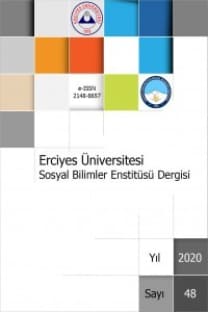ÖĞRETMENLERN SOSYAL-DUYGUSAL DESTEK DAVRANIŞLARI VE ÖĞRENCİLERİN ALGILADIĞI ÖĞRENME DÜZEYİ
Algılanan öğrenme miktarı, sosyal-duygusal destek, öğretmen davranışları
TEACHERS’ BEHAVIORS OF SOCIAL-EMOTIONAL SUPPORT AND STUDENTS ’ PERCEIVED AMOUNT OF LEARNING (PAL)
___
Adler, N. L., & Moulton, M. R. (1998). The eye of the beholder: Middle schoolers talk about caring. Schools in the Middle, January/February, 7(3), 6-7.Banner, J. M. Jr., & Cannon, H. C. (1997). The elements of teaching. New Haven, CT: Yale University Press.
Bloom, B. S. (1976). Human characteristics and school learning. New York: McGraw-Hill.
Cooper, B. (2004). Empathy, interaction and caring: Teachers roles in a constrained environment. Pastoral Care, September, 12-24.
Csikszentmihalyi, M., & McCormack, J. (1986). The influence of teachers. Phi Delta Kappan, 67, 415-419.
Davidson, A. (1999). Negotiating social differences: Youths' assessments of educators' strategies. Urban Education, 34, 338-369.
Davidson, A., & Phelan, P. (1999). Students' multiple worlds. In Advances in motivation and achievement: Role of context, 2, 233-283. Stamford, CT: JAI Press.
Hirst, P. H., & Peters, R. S. (1971). The logic of education. New York: Humanities Press.
Kress, J. S., Norris, J. A., Schoenholz, D. A., Elias, M. J., & Seigle, P. (2004). Bringing together educational standards and social and emotional learning: Making the case for educators. American Journal of Education, 111, 68- 89.
LeDoux, J. E. (2000). Emotion circuits in the brain. Annual Review of Neuroscience, 23, 155-184.
Lickona, T. (1991). Educating for character: How our schools can teach respect and responsibility. New York: Bantam Books.
Noddings, N. (1984). Caring: A feminine approach to ethics and moral education. Berkeley, CA: University of California Press.
Oser, F. K. (1994). Moral perspectives on teaching. Review of Research in Education, 20, 57-127.
Oser, F. K., Dick, A., & Patry, J. L. (1992). Responsibility, effectiveness, and the domains of educational research. In F. K. Oser, A. Dick, and J. L. Patry (Eds.), Effective and responsible teaching: The new synthesis (pp. 3-13). San Francisco, CA: Jossey-Bass.
Palmer, P. J. (1998). The courage to teach: Exploring the inner landscape of a teacher's life. San Francisco, CA: Jossey-Bass.
Pianta, R. (1999). Enhancing relationships between children and teachers. Washington, DC: American Psychological Association.
Protheroe, N. (2005). Learning and the teacher-student connection. Principal, October/ September, 50-52.
Ryan, R., & Deci, E. (2000). Self-determination theory and the facilitation of intrinsic motivation, social development, and well being. American Psychologist, 55, 68-78.
Sockett, H. (1993). The moral base for teacher professionalism. New York: Teachers College Press.
Stipek, D. (2006). Relationships matter. Educational Leadership, 64(1), 46-49.
Täte, P. M. (2006). Academic and relational responsibilities of teaching. Journal of Education, 187(3), 1-20.
Wang, M. C., Haertal, G. D., & Wahberg, H. J. (1993). Toward a knowledge base for school learning. Review of Educational Research, 63, 249-294.
Zins, J. E., Weissberg, R. P., Wang, M. C., & Walberg, H.J. (Eds.). (2004). Building school success through social and emotional learning. New York: Teachers College Press.
This document was created with Win2PDF available at
The unregistered version of Win2PDF is for evaluation or non-commercial use only.
This page will not be added after purchasing Win2PDF. http://www.win2pdf.com.
- Yayın Aralığı: Yılda 2 Sayı
- Yayıncı: Erciyes Üniversitesi
“GÜNEŞE YOLCULUK” VE “BERLİN İN BERLİN” FİLMLERNDE İKİ EKSEN, İKİ DİL OYUNU, TEK OLGU: GÖÇ
ÜNİVERSİTE GENÇLİĞİNDE MARKA-TÜKETİM BAĞLAMINDA BİLİNÇ-BİLİŞ DÜZEYİ
TAĞAR (ST. THEODORE) KİLİSESİ DUVAR RESİMLERİ
ÖĞRETMENLERN SOSYAL-DUYGUSAL DESTEK DAVRANIŞLARI VE ÖĞRENCİLERİN ALGILADIĞI ÖĞRENME DÜZEYİ
DUYGUSAL ZEKA (EI) ÜZERNE FARKLI ELEŞTİRİ VE DEĞERLENDİRMELER
TARHSEL ROMAN VE BİR GÖÇ ROMANI OLARAK BİR TÜRK AİLESİN ÖYKÜSÜ
OKUMAYI NASIL SEVDİLER? ÜNİVERSİTE ÖĞRENCİLERİ İLE MÜLAKATLAR
SERBEST BÖLGELERİN EKONOMİK ETKİLERİ: KAYSERİ SERBEST BÖLGESİ İÇİN BİR UYGULAMA
Nısfet UZAY, H.hayrettin TIRAŞ
BURHAN CAHİT MORKAYA’NIN “İNKILÂP SEtâSİ” GENEL BAŞLIĞIYLA YAYIMLANAN BEŞ ESERİ
MÜZİK KURAMCISI VE EFSANEVİ KİŞİLİK OLARAK SAFİ YYÜDDÎN-1 URMEVİ
